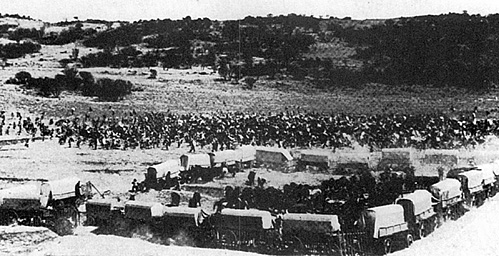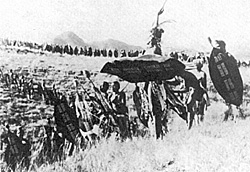Like so many of Britain's old colonies, South Africa boasted a booming film industry in the first decades of the twentieth century. It is hardly surprising that South Africa's first historical film should be concerned with that most important historical event, the Great Trek of the 1830's, which hard-line Afrikaners regard as the birth of their nation, and which holds an emotional appeal rather greater than that which the opening of the old west does to Americans.
 THEY BUILT A NATION An epic reconstruction of the battle of Blood River. (Photo courtesy Mr. S. Bourquin.)
THEY BUILT A NATION An epic reconstruction of the battle of Blood River. (Photo courtesy Mr. S. Bourquin.)
DE VOORTREKKERS, made in 1916, was an extremely ambitious film, a project far in excess of anything the industry had tried before. It chronicled the Boer discontent with British rule in the old Cape Colony which led to the wholesale emmigrations, included panoramic views of wagon trains rumbling across the veld, and culminated in the treacherous massacre of Trek leader Piet Retief by the Zulu King Dingane, and Dingane's subsequent come-uppance at the battle of Blood River. Considerable attempts were made to ensure the accuracy of these sequences, so much so that the filming of the Blood River sequence led to tragedy. Several hundred Zulus were employed as extras, and at a given signal charged furiously at the Boer laager. Unfortunately, once they had started, no one seemed able to stop them, and instead of recoiling under heavy fire as the script demanded, they smashed their way in and a real-life punch-up developed with the European actors.
A detachment of mounted police, acting as security advisors, waded in and separated the combatants, but several Zulus fell into the river, and one was drowned. Though the resulting footage was extremely realistic, it was, of course, totally inaccurate, and the whole sequence had to be filmed again a week or two later when the extras had cooled down. It's perhaps worth pointing out that in 1916 real Zulu battles were still very much within living memory, and it was only ten years previously that the last native rebellion in Natal had been crushed!
A sequel, SYMBOL OF SACRIFICE was history on the grand scale, this time re-telling the 1879 Zulu War, concentrating particularly on the battle of lsandhlwana and the death of the Prince Imperial. Much of it was to be filmed on the actual sites-which were not so heavily dotted with memorials then as they are now.
The centenary of the Great Trek in 1938, and its attendant upsurge in patriotic fever led to yet another film extolling the virtues of Afrikanerdom, BOU VAN 'N NASIE - THEY BUILT A NATION. This was nothing less than an entire history of European South Africa, beginning with the landing of Jan van Reibek in 1652 and culminating in a reconstruction of - you've guessed it - the battle of Blood River. Although heavily laced with Boer propaganda, the sequences dealing with the 1838 war with the Zulus are quite authentic.
Much as one might make excuses, there is no getting away from the fact that Dingane's actions in inviting Retief and his followers to a peaceful dancing display and then massacring the lot of them was pretty dastardly; the director was content to let such events speak for themselves. Dingane's Day, incidentally, which commemorates the Boer victory, is still a national holiday in South Africa, and the excuse for much Afrikaner celebrations. Needless to say it is less than popular with the Zulus, who find such prolonged crowing intolerable.
Perhaps the best known film concerning the Zulu Wars was Cy Endfield's 1964 ZULU. Essentially an Anglo-American production for international release, ZULU was mercifully free from the prejudice which marred the home grown project, though Stanley Baker, co-producer as well as star, insisted on blowing the trumpet for his native Wales. In fact, though it has become very Welsh since, there were not that many Welsh in the 24th Foot in 1879, and it has been said that there were as many Londoners at Rorke's Drift as Welshmen! Broadly, in case there are still some of you out there who haven't seen it, ZULU was a reconstruction of the action at Rorke's Drift in January 1879 when a force of 4,000 Zulus was defeated by scarcely one hundred red-coats, who earned themselves eleven VCs in the process. ZULU took considerable liberties with geographical and historical fact.
It was filmed in one of the most spectacular parts of the National Park of Natal, overlooked by a towering spur of the Drakensburg mountains, a far cry from the rather ordinary site of the real Rorke's Drift. Characters were added or subtracted as the story required, and the sequence of Zulu attacks re-arranged for the most dramatic impact. Most of the characters are essentially cliched--we have the upper class fop, the dour professional, the rascally 'other ranks' type who turns out to be true blue when the chips are down, and so on, but they are drawn for once in some depth, and the acting is impeccable, particularly from Michael Caine in his first starring role as Lieutenant Bromhead.
 ZULU. Courage and discipline.
ZULU. Courage and discipline.
Despite its faults, ZULU is a fine film, and only the most hard-hearted purist could find it in him to reject it. In stance it is refreshingly anti-war, benifiting from a rejection of jingoism that was beginning to creep into war epics in the early sixties. It is beautifully photographed making the most of its dramatic location and colorful subjects. Unlike films about the Zulus before it, the warriors themselves are not merely there as cannon-fodder, but their courage and discipline forms an essential theme of the film.
And those battle scenes ... Carefully edited to mount in tension, each Zulu attack is more dramatic than the one before until they culminate finally in a heart-stopping montage of crashing vollies and falling warriors as the last assault is repulsed. There can't be many films which can boast a battle scene which remains so gripping and so exciting for the best part of half the film.
The success of ZULU prompted the South African industry to try again to capitalize on the commercial appeal of its past. In 1968 a film was made called simply MAJUBA, about the First Boer War of the 1880s. Although by all accounts quite spectacular, it concentrated on British defeats, and thereby earned the reputation of being biased. In 1973 poor old Din- gane was forced to relive his sins once again in yet another version of DIE VOORTREKKERS. SHANGANI PATROL, released in 1970, concerned the Matabele War of 1893 and the last stand of Major Allen Wilson and his men.
And so we arrive at ZULU DAWN. With so much popular interest in the period, the producers had intended to capitalize on the centenary, and open the film with a blaze of publicity on January 22nd last year, the 100th anniversary of the battle of Isandhlwana which the film purports to depict. However, the best laid plans of mice and men . . . and how!
ZULU DAWN was plagued with problems from the start of production. The script had called for large numbers of Zulu extras, and the producers had no doubt counted on cheap labor. The Zulus would have none of it, however, and KwaZulu's Prime Minister, Chief Catsha Buthelezi, ordered his countrymen to boycott it. Although this problem was eventually sorted out, relations with the black workers were to remain strained, leading to arguments over work permits and an unhealthy degree of racial tension.
Nor was the trouble confined to the blacks; some of the white extras were a rum lot, and bouts of drinking and fighting when the weekly pay check was doled out were not unheard of. A stuntman was severely injured when a cannon rolled over him, and more than one glittering star went head first into the dust when he stumbled on the rocky veld. The company ran up such debts during its time on location that creditors slapped an injunction on it and prevented its release until the end of last year. To cap it all, up to an hour and a half was cut of the final print to ensure a commercial release, and in places it shows.
So what sort of a film did it turn out, after such trials and tribulations? In cinematic terms, it is not a patch on ZULU. Although it boasts a host of stars-many, like Burt Lancaster, Peter O'Toole and Sir John Mills, are of international repute, and the rest are mostly much respected British TV actors -characterization is minimal. O'Toole plays Lord Chelmsford with an icy arrogance, and Burt Lancaster struggles manfully with the role of Colonel Durnford, but is hopelessly miscast, and the rest come and go before there is scarcely time to recognize them.
The best performance, surprisingly, is that from Simon Sabela, who, although all his dialogue is in Zulu, makes a superb Cetshwayo. In opening the film out, ZULU DAWN looses that sense of claustrophobic tension which made ZULU so gripping. Like ZULU, it is antiwar in its stance, but it goes over the top in its attempt to bash imperialism.
But what of the action, I hear you cry? Well, here at least is a plus. It is extraordinarily spectacular. When Chelmsford's army is on the move, the screen explodes with long scarlet slashes of infantry columns, and when the Zulus finally appear, spilling down from a range of hills, they are breathtaking,. The photography and sense of color is superb, and some care has been taken with the locations. The river crossing was actually filmed at Rorke's Drift (admittedly in reverse; it was filmed crossing from the Zulu side into Natal!), and at one point we are treated with a long distance view of the real Mt. Isandhlwana.
As for historical accuracy-the uniforms of the British troops are more accurate than those in ZULU, though some are a bit plasticy, and there are lancers where there souldn't be any, but considerable attempts have been made to insure the correct appearance of some of the Colonial troops, the NCC, Natal Carbineers and so forth. The sequences in the Zulu kraal are very good, though by and large the warriors are not as fearsome as they were in ZULU.
Plot-wise, the action follows the build-up to the war, the invasion, and the battle, and ends with Chelmsford's return to the devastated camp after the battle. There is a brief skirmish on the way, loosely based on the action at Sihayo's kraal, and throughout the battle scene, the events portrayed are broadly accurate. The discovery of the impi, Durnford's defense of the donga, the over-running of the rocket battery, the ammunition shortage, the fall of the camp-it's all there, more or less recognizable.
Nevertheless, the overall impression that ZULU DAWN gives is one of an opportunity missed. If only the characters had been developed more . . . if only the editing had been better . . . if only its release had not been so hurried. ZULU DAWN is worth seeing, and some of it is actually very good, but it is by no means the definitive Zulu War film. Next time, perhaps.
Back to Table of Contents -- Courier Vol. III #2
To Courier List of Issues
To MagWeb Master Magazine List
© Copyright 1981 by The Courier Publishing Company.
This article appears in MagWeb (Magazine Web) on the Internet World Wide Web.
Other military history articles and gaming articles are available at http://www.magweb.com